Entity, Sets & Keys | Database Management System (DBMS) - Computer Science Engineering (CSE) PDF Download
Introduction of ER Model
ER Model is used to model the logical view of the system from data perspective which consists of these components:
1. Entity, Entity Type, Entity Set
An Entity may be an object with a physical existence – a particular person, car, house, or employee – or it may be an object with a conceptual existence – a company, a job, or a university course.
An Entity is an object of Entity Type and set of all entities is called as entity set. e.g.; E1 is an entity having Entity Type Student and set of all students is called Entity Set. In ER diagram, Entity Type is represented as:
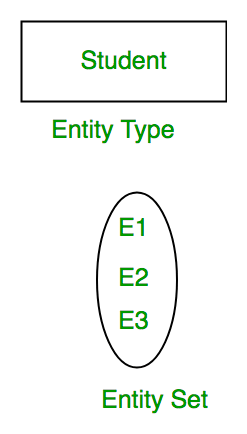
2. Attribute(s)
Attributes are the properties which define the entity type. For example, Roll_No, Name, DOB, Age, Address, Mobile_No are the attributes which defines entity type Student. In ER diagram, attribute is represented by an oval.

(i) Key Attribute: The attribute which uniquely identifies each entity in the entity set is called key attribute. For example, Roll_No will be unique for each student. In ER diagram, key attribute is represented by an oval with underlying lines.

(ii) Composite Attribute: An attribute composed of many other attribute is called as composite attribute. For example, Address attribute of student Entity type consists of Street, City, State, and Country. In ER diagram, composite attribute is represented by an oval comprising of ovals.

(iii) Multivalued Attribute: An attribute consisting more than one value for a given entity. For example, Phone_No (can be more than one for a given student). In ER diagram, multivalued attribute is represented by double oval.
(iv) Derived Attribute: An attribute which can be derived from other attributes of the entity type is known as derived attribute. Example: Age (can be derived from DOB). In ER diagram, derived attribute is represented by dashed oval.

The complete entity type Student with its attributes can be represented as:
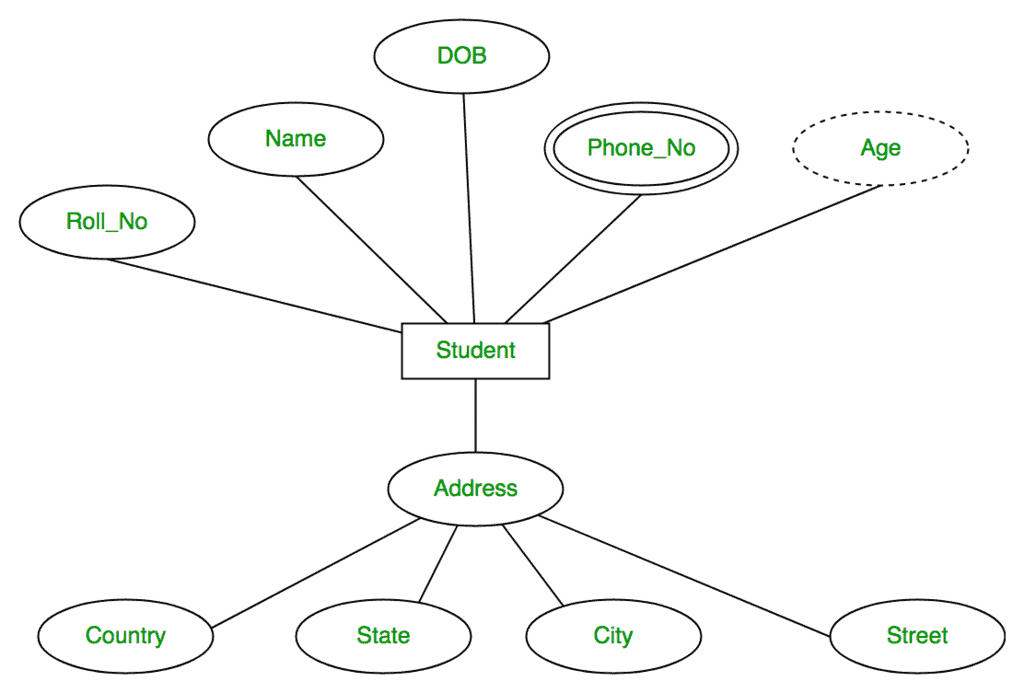
Relationship Type and Relationship Set
A relationship type represents the association between entity types. For example, ‘Enrolled in’ is a relationship type that exists between entity type Student and Course. In ER diagram, relationship type is represented by a diamond and connecting the entities with lines.

A set of relationships of same type is known as relationship set. The following relationship set depicts S1 is enrolled in C2, S2 is enrolled in C1 and S3 is enrolled in C3.
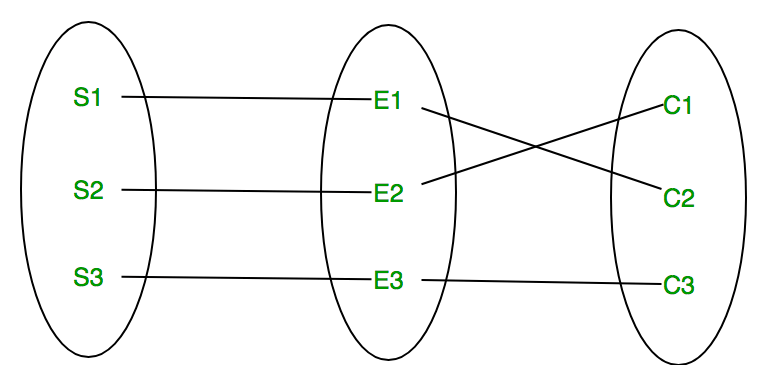
1. Degree of a relationship set
The number of different entity sets participating in a relationship set is called as degree of a relationship set.
(i) Unary Relationship: When there is only ONE entity set participating in a relation, the relationship is called as unary relationship. For example, one person is married to only one person.

(ii) Binary Relationship: When there are TWO entities set participating in a relation, the relationship is called as binary relationship.For example, Student is enrolled in Course.

(iii) n-ary Relationship: When there are n entities set participating in a relation, the relationship is called as n-ary relationship.
2. Cardinality
The number of times an entity of an entity set participates in a relationship set is known as cardinality.
Cardinality can be of different types
(i) One to one: When each entity in each entity set can take part only once in the relationship, the cardinality is one to one. Let us assume that a male can marry to one female and a female can marry to one male. So the relationship will be one to one.

Using Sets, it can be represented as:
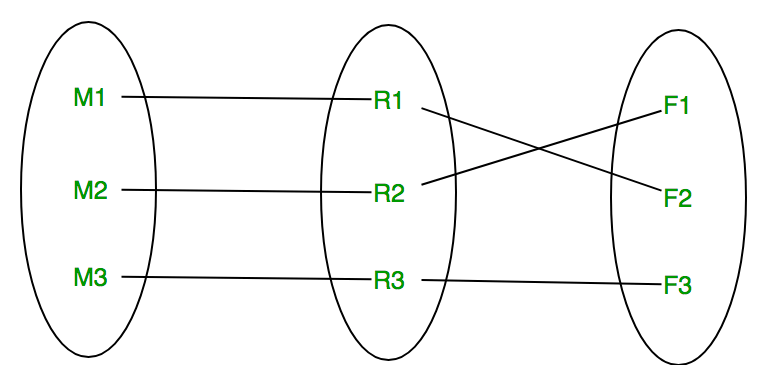
(ii) Many to one: When entities in one entity set can take part only once in the relationship set and entities in other entity set can take part more than once in the relationship set, cardinality is many to one. Let us assume that a student can take only one course but one course can be taken by many students. So the cardinality will be n to 1. It means that for one course there can be n students but for one student, there will be only one course.

Using Sets, it can be represented as:
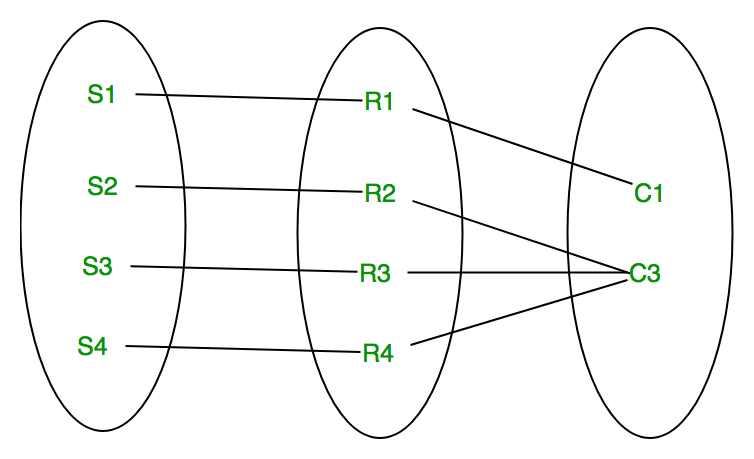
In this case, each student is taking only 1 course but 1 course has been taken by many students.
(iii) Many to many: When entities in all entity sets can take part more than once in the relationship cardinality is many to many. Let us assume that a student can take more than one course and one course can be taken by many students. So the relationship will be many to many.

Using sets, it can be represented as:
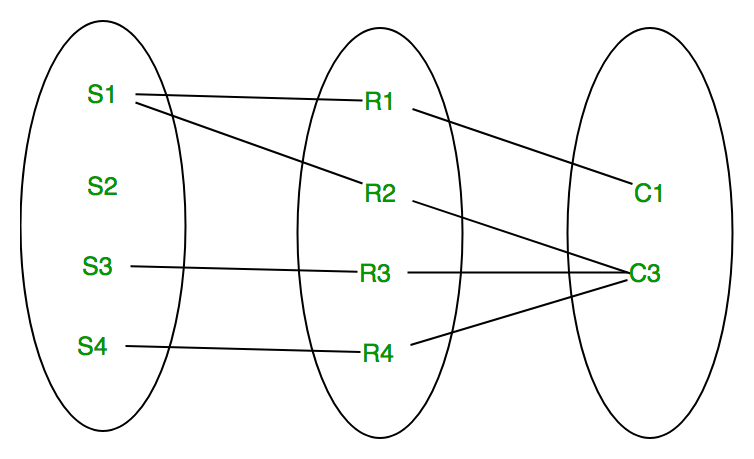
In this example, student S1 is enrolled in C1 and C3 and Course C3 is enrolled by S1, S3 and S4. So it is many to many relationships.
Participation Constraint
Participation Constraint is applied on the entity participating in the relationship set.
- Total Participation: Each entity in the entity set must participate in the relationship. If each student must enroll in a course, the participation of student will be total. Total participation is shown by double line in ER diagram.
- Partial Participation: The entity in the entity set may or may NOT participate in the relationship. If some courses are not enrolled by any of the student, the participation of course will be partial.
The diagram depicts the ‘Enrolled in’ relationship set with Student Entity set having total participation and Course Entity set having partial participation.

Using set, it can be represented as,
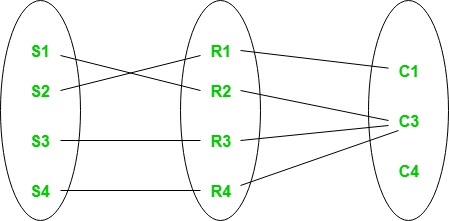
Every student in Student Entity set is participating in relationship but there exists a course C4 which is not taking part in the relationship.
Weak Entity Type and Identifying Relationship
As discussed before, an entity type has a key attribute which uniquely identifies each entity in the entity set. But there exists some entity type for which key attribute can’t be defined. These are called Weak Entity type.
For example, A company may store the information of dependants (Parents, Children, Spouse) of an Employee. But the dependents don’t have existence without the employee. So Dependent will be weak entity type and Employee will be Identifying Entity type for Dependant.
A weak entity type is represented by a double rectangle. The participation of weak entity type is always total. The relationship between weak entity type and its identifying strong entity type is called identifying relationship and it is represented by double diamond.
Different Types of Database Keys
- Candidate Key
- Primary Key
- Super Key
- Alternate Key
- Foreign Key
- Composite Key
Candidate Key
The minimal set of attributes that can uniquely identify a tuple is known as a candidate key. For Example, STUD_NO in STUDENT relation.
- It is a minimal super key.
- It is a super key with no repeated data is called a candidate key.
- The minimal set of attributes that can uniquely identify a record.
- It must contain unique values.
- It can contain NULL values.
- Every table must have at least a single candidate key.
- A table can have multiple candidate keys but only one primary key.
- The value of the Candidate Key is unique and may be null for a tuple.
- There can be more than one candidate key in a relationship.
Example:
STUD_NO is the candidate key for relation STUDENT.
Table STUDENT

The candidate key can be simple (having only one attribute) or composite as well.
Example:
{STUD_NO, COURSE_NO} is a composite
candidate key for relation STUDENT_COURSE.
Table STUDENT_COURSE

Note: In SQL Server a unique constraint that has a nullable column, allows the value ‘null‘ in that column only once. That’s why the STUD_PHONE attribute is a candidate here, but can not be a ‘null’ value in the primary key attribute.
Primary Key
There can be more than one candidate key in relation out of which one can be chosen as the primary key. For Example, STUD_NO, as well as STUD_PHONE, are candidate keys for relation STUDENT but STUD_NO can be chosen as the primary key (only one out of many candidate keys).
- It is a unique key.
- It can identify only one tuple (a record) at a time.
- It has no duplicate values, it has unique values.
- It cannot be NULL.
- Primary keys are not necessarily to be a single column; more than one column can also be a primary key for a table.
Example:
STUDENT table -> Student(STUD_NO, SNAME,
ADDRESS, PHONE) , STUD_NO is a primary key
Table STUDENT

Super Key
The set of attributes that can uniquely identify a tuple is known as Super Key. For Example, STUD_NO, (STUD_NO, STUD_NAME), etc. A super key is a group of single or multiple keys that identifies rows in a table. It supports NULL values.
- Adding zero or more attributes to the candidate key generates the super key.
- A candidate key is a super key but vice versa is not true.
- Super Key values may also be NULL.
Example:
Consider the table shown above.
STUD_NO+PHONE is a super key.
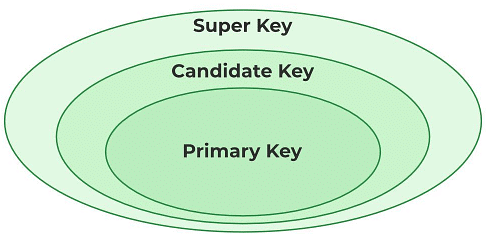
Alternate Key
The candidate key other than the primary key is called an alternate key.
- All the keys which are not primary keys are called alternate keys.
- It is a secondary key.
- It contains two or more fields to identify two or more records.
- These values are repeated.
- Eg:- SNAME, and ADDRESS is Alternate keys
Example:
Consider the table shown above.
STUD_NO, as well as PHONE both,
are candidate keys for relation STUDENT but
PHONE will be an alternate key
(only one out of many candidate keys).
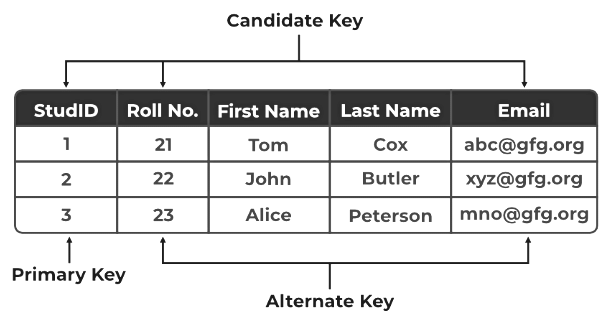
Foreign Key
If an attribute can only take the values which are present as values of some other attribute, it will be a foreign key to the attribute to which it refers. The relation which is being referenced is called referenced relation and the corresponding attribute is called referenced attribute. The referenced attribute of the referenced relation should be the primary key to it.
- It is a key it acts as a primary key in one table and it acts as
- secondary key in another table.
- It combines two or more relations (tables) at a time.
- They act as a cross-reference between the tables.
For example, DNO is a primary key in the DEPT table and a non-key in EMP
Example:
- Refer Table STUDENT shown above.
- STUD_NO in STUDENT_COURSE is a
- foreign key to STUD_NO in STUDENT relation.
Table STUDENT_COURSE

It may be worth noting that, unlike the Primary Key of any given relation, Foreign Key can be NULL as well as may contain duplicate tuples i.e. it need not follow uniqueness constraint. For Example, STUD_NO in the STUDENT_COURSE relation is not unique. It has been repeated for the first and third tuples. However, the STUD_NO in STUDENT relation is a primary key and it needs to be always unique, and it cannot be null.
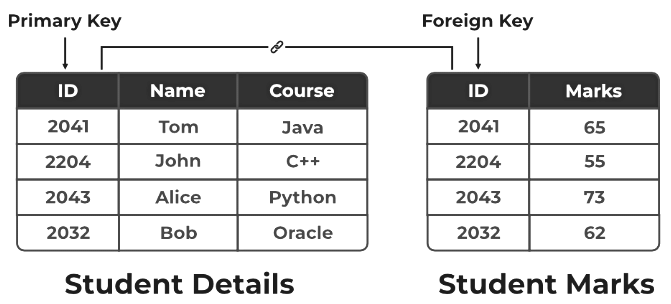
Composite Key
Sometimes, a table might not have a single column/attribute that uniquely identifies all the records of a table. To uniquely identify rows of a table, a combination of two or more columns/attributes can be used. It still can give duplicate values in rare cases. So, we need to find the optimal set of attributes that can uniquely identify rows in a table.
- It acts as a primary key if there is no primary key in a table
- Two or more attributes are used together to make a composite key.
- Different combinations of attributes may give different accuracy in terms of identifying the rows uniquely.
Example:
FULLNAME + DOB can be combined
together to access the details of a student.
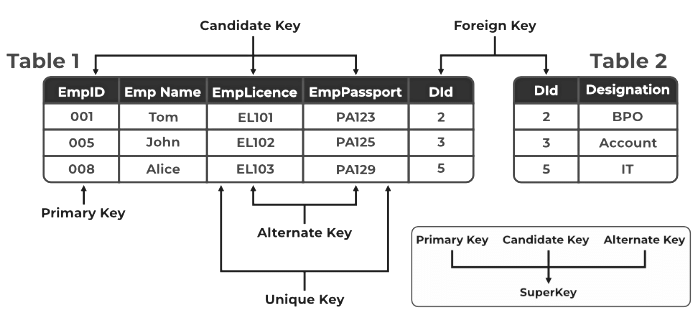
Conclusion
In conclusion, the relational model makes use of a number of keys: Candidate keys allow for distinct identification, the Primary key serves as the chosen identifier, Alternate keys offer other choices, and Foreign keys create vital linkages that guarantee data integrity between tables. The creation of strong and effective relational databases requires the thoughtful application of these keys.
|
62 videos|99 docs|35 tests
|
FAQs on Entity, Sets & Keys - Database Management System (DBMS) - Computer Science Engineering (CSE)
| 1. What is the ER Model? |  |
| 2. What are entities in the ER Model? |  |
| 3. What are sets in the ER Model? |  |
| 4. What are keys in the ER Model? |  |
| 5. How does the ER Model help in database design? |  |
















